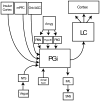The anatomical and functional relationship between the P3 and autonomic components of the orienting response
- PMID: 20557480
- PMCID: PMC3797154
- DOI: 10.1111/j.1469-8986.2010.01057.x
The anatomical and functional relationship between the P3 and autonomic components of the orienting response
Abstract
Many psychophysiologists have noted the striking similarities between the antecedent conditions for the P3 component of the event-related potential and the orienting response: both are typically elicited by salient, unexpected, novel, task-relevant, and other motivationally significant stimuli. Although the close coupling of the P3 and orienting response has been well documented, the neural basis and functional role of this relationship is still poorly understood. Here we propose that the simultaneous occurrence of the P3 and autonomic components of the orienting response reflects the co-activation of the locus coeruleus-norepinephrine system and the peripheral sympathetic nervous system by their common major afferent: the rostral ventrolateral medulla, a key sympathoexcitatory region. A comparison of the functional significance of the locus coeruleus-norepinephrine system and the peripheral sympathetic nervous system suggests that the P3 and orienting response reflect complementary cognitive and physical contributions to the mobilization for action following motivationally significant stimuli.
Keywords: Arousal; Noradrenergic; Norepinephrine; Orienting response; P3; P300; Reticular formation; Rostral ventrolateral medulla.
Copyright © 2010 Society for Psychophysiological Research.
Similar articles
-
Decision making, the P3, and the locus coeruleus-norepinephrine system.Psychol Bull. 2005 Jul;131(4):510-32. doi: 10.1037/0033-2909.131.4.510. Psychol Bull. 2005. PMID: 16060800 Review.
-
Discharge of noradrenergic locus coeruleus neurons in behaving rats and monkeys suggests a role in vigilance.Prog Brain Res. 1991;88:501-20. doi: 10.1016/s0079-6123(08)63830-3. Prog Brain Res. 1991. PMID: 1813931 Review.
-
Integration of three investigations of Novelty, Intensity, and Significance in dishabituation paradigms: A study of the phasic Orienting Reflex.Int J Psychophysiol. 2020 Jan;147:113-127. doi: 10.1016/j.ijpsycho.2019.11.009. Epub 2019 Nov 25. Int J Psychophysiol. 2020. PMID: 31778726
-
Are the P600 and P3 ERP components linked to the task-evoked pupillary response as a correlate of norepinephrine activity?Psychophysiology. 2024 Jul;61(7):e14565. doi: 10.1111/psyp.14565. Epub 2024 Mar 12. Psychophysiology. 2024. PMID: 38469647
-
The temporal orienting P3 effect to non-target stimuli: does it reflect motor inhibition?Biol Psychol. 2012 Feb;89(2):433-43. doi: 10.1016/j.biopsycho.2011.12.010. Epub 2011 Dec 21. Biol Psychol. 2012. PMID: 22197881
Cited by
-
The Impact of Deliberative Strategy Dissociates ERP Components Related to Conflict Processing vs. Reinforcement Learning.Front Neurosci. 2012 Apr 3;6:43. doi: 10.3389/fnins.2012.00043. eCollection 2012. Front Neurosci. 2012. PMID: 22493568 Free PMC article.
-
Δ9-THC reduces reward-related brain activity in healthy adults.Psychopharmacology (Berl). 2022 Sep;239(9):2829-2840. doi: 10.1007/s00213-022-06164-y. Epub 2022 May 25. Psychopharmacology (Berl). 2022. PMID: 35612654 Free PMC article.
-
The influence of the noradrenergic system on optimal control of neural plasticity.Front Behav Neurosci. 2013 Nov 13;7:160. doi: 10.3389/fnbeh.2013.00160. eCollection 2013. Front Behav Neurosci. 2013. PMID: 24312028 Free PMC article.
-
Mood congruent tuning of reward expectation in positive mood: evidence from FRN and theta modulations.Soc Cogn Affect Neurosci. 2017 May 1;12(5):765-774. doi: 10.1093/scan/nsx010. Soc Cogn Affect Neurosci. 2017. PMID: 28199707 Free PMC article.
-
Evidence of elevated situational awareness for active duty soldiers during navigation of a virtual environment.PLoS One. 2024 May 10;19(5):e0298867. doi: 10.1371/journal.pone.0298867. eCollection 2024. PLoS One. 2024. PMID: 38728266 Free PMC article.
References
-
- Allport DA. Selection for action: Some behavioral and neurophysiological considerations of attention and action. In: Heuer H, Sanders AF, editors. Perspectives on perception and action. Hillsdale, NJ: Lawrence Erlbaum Associates Inc; 1987. pp. 395–419.
-
- Amaral DG, Sinnamon HM. The locus coeruleus: neurobiology of a central noradrenergic nucleus. Progress in Neurobiology. 1977;9:147–196. - PubMed
-
- Antikainen J, Niemi P. Neuroticism and the pupillary response to a brief exposure to noise. Biological Psychology. 1983;17:131–135. - PubMed
-
- Arnsten AF, Goldman-Rakic PS. Selective prefrontal cortical projections to the region of the locus coeruleus and raphe nuclei in the rhesus monkey. Brain Research. 1984;306:9–18. - PubMed
Publication types
MeSH terms
Grants and funding
LinkOut - more resources
Full Text Sources
Miscellaneous


